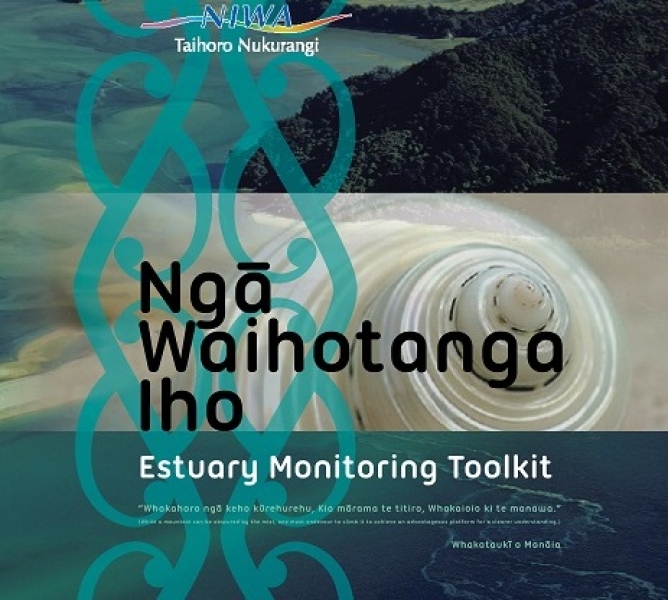Ngā Waihotanga Iho has been developed to provide tangata whenua with tools to measure environmental changes in their estuaries. While Ngā Waihotanga Iho is based on sound science principles, it is also underpinned by tangata whenua values.
The development of the toolkit unfolded in three phases: (1) hui with Ngāti Hikairo at Kāwhia (West Coast) and Ngāti Whanaunga and Ngāti Pūkenga at Manaia (Coromandel); (2) toolkit development; and (3) field trials with Ngāti Hikairo, Ngāti Whanaunga and Ngāti Pūkenga.
Phase 1 Hui with hapū
For the toolkit to be effective and relevant for whanua, hapū and iwi, it must address those changes in the estuary/harbour environment that affect activities and values of tangata whenua . Such values may be economic (e.g., tourism, commercial fisheries), social (e.g., health and safety, recreation), cultural (e.g., collection of kaimoana, retention of matauranga Maori, mana, wairua, taonga species, kaitiakitanga) or specifically environmental (e.g., indigenous biodiversity, clean water, fresh air). Thus, the first phase of the development of the toolkit aimed to identify tangata whenua values. We worked with three hapū Ngāti Hikairo (Kāwhia) and Ngāti Whanaunga and Ngāti Pūkenga (Manaia). Information on values and observations of environmental changes at Kāwhia and Manaia were collected through detailed interviews, hui and a survey questionnaire that was widely distributed within each hapū. NIWA scientists and hapū members also took part in field trips to discuss the environmental changes that they have observed at Kawhia and Manaia over the last 50 years or so.
Phase 2 Developing the Toolkit
Based on the hui with Ngāti Hikairo, Ngāti Whanaunga and Ngāti Pūkenga, the NIWA team were then able to design, develop and test monitoring tools that targetted those environmental changes that impact on the most important and representative of these values.A number of different monitoring tools were considered, trialled, and some were discarded in the process. The final set of tools is grouped into general themes (modules) that relate to physical, chemical and biological aspects of estuaries. Each module has been designed so that they can be used ‘stand alone’ or together, depending on the range of environmental issues to be considered.
Phase 3 Field trials
In February 2009 NIWA scientists from the Hamilton, Auckland and Wellington campuses converged on Manaia estuary and spent four days working with whanau from Ngāti Whanaunga, Ngāti Pūkenga and the Coromandel Area School. The intention of the trials was to evaluate how easily the tools can be used and to identify how the tools could be improved. The field trial at Manaia was hugely successful with participants providing valuable feedback on all aspects of the toolkit. Similar field tests were also carried out at Kāwhia with Ngāti Hikairo.
Naming the toolkit
The name of the toolkit, Ngā Waihotanga Iho, was suggested by our hapū partners, Ngāti Hikiaro (Käwhia) and Ngāti Whanaunga, Ngāti Pūkenga (Manāia). After deliberation by kaumātua, and bearing in mind the kaitiaki values that guide tangata whenua and the purpose of the toolkit, the thought "ānei ngä waihonga me tiaki tātou" came about, which later evolved into the current name Ngā Waihotanga Iho: what has been left behind we should look after.
Acknowledgements
A number of individuals, organisations and hapū have contributed to the development of Ngā Waihotanga Iho. First and foremost we would like to thank Ngāti Hikairo at Kāwhia and Ngāti Whanaunga and Ngāti Pūkenga at Manaia for working with us to develop the toolkit. We would also like to individually thank Mike Baker (Ngāti Whanaunga and Ngäti Pükenga), Frank Thorne (Ngāti Hikairo), Tangihaere Ormsby (Ngā Taiātea Wharekura, Hamilton), Kristina Hillock (Department of Conservation, Waikato Conservancy), Dr Anne Hume (School of Education, University of Waikato), Mr Steve Pullan and Ms Christine Bowden (Ministry of Fisheries).
Project Team
Andrew Swales, Darcel Rickard, Carolyn Lundquist, Rupert Craggs, Fleur Matheson, Mark Morrison, Michael Ahrens, Rob Davies-Colley, Rebecca Stott, Wakaiti Dalton, Apanui Skipper, Weno Iti, Aarti Wadhwa - (NIWA).
Jenni Fitzgerald, Malene Felsing and Graeme Silver - (Waikato Regional Council).
Max Oulton - (University of Waikato)
Amber Roling and Dave Mansergh - (Mansergh Graham Landscape Architects)
Alastair Jamieson - (Wild Earth Media)
Dr Guy Penny (Aranovus Research)
Funding
Ngā Waihotanga Iho has been developed as part of NIWA’s Effects-Based Protection and Management of Aquatic Ecosystems programme, funded by the Foundation for Research, Science and Technology, (MBIE) (C01X0307). The key motivation for this research programme is the fact that many of New Zealand’s lakes, rivers and estuaries have been degraded by the activities of people. The main goal of the programme is to develop tools for managing aquatic ecosystems. Ngä Waihotanga Iho is one of those tools. Collaboration with our hapü partners to identify values and perceptions of environmental changes in their estuaries was co-funded by the Ministry for the Environment.
The Ministry for the Environment provided support for the evaluations of tangata whenua values and perceptions of environmental changes at Käwhia and Manaia. planned and implemented these studies.

